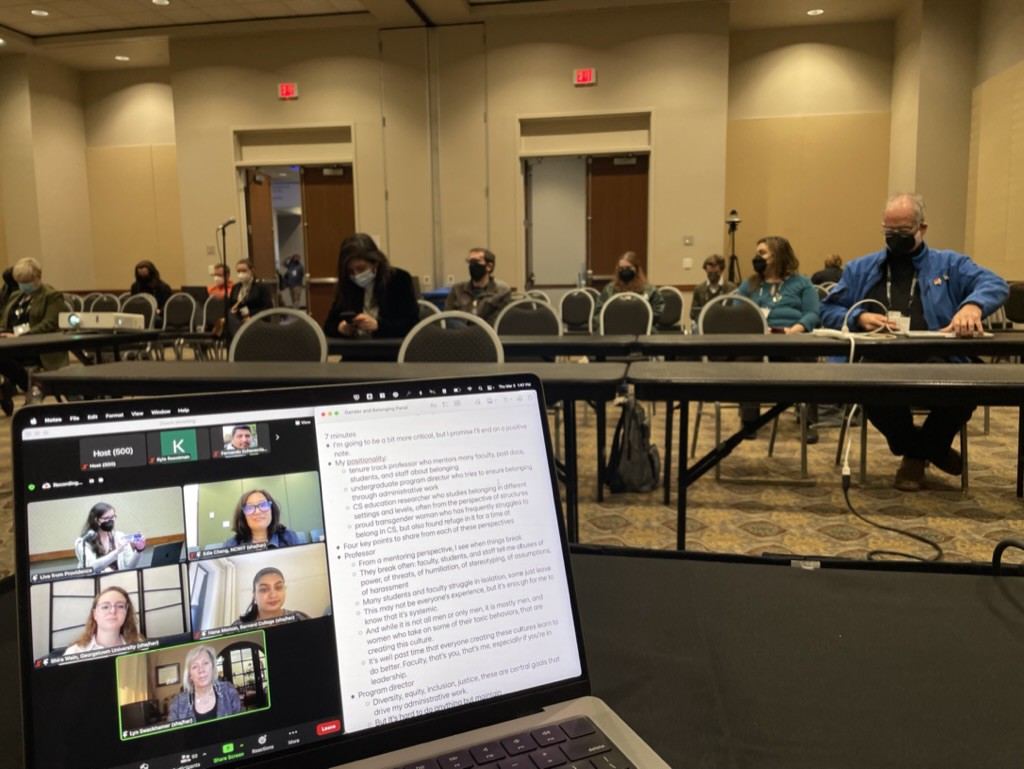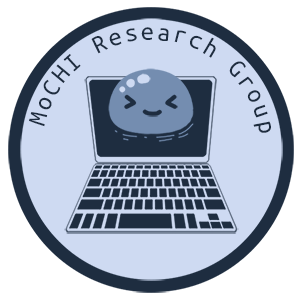The 2022 SIGCSE Technical Symposium was held on March 2-5 and brought together students, researchers, industry leaders, and professors of all disciplines virtually and in Providence, Rhode Island. I joined SIGCSE (Special Interest Group on Computer Science Education) virtually as a student attendee and panelist through the National Center for Women and Information Technology. Much of why I was interested in joining this interdisciplinary conference was because of my previous experiences with being a computer science peer teacher. Although I didn’t have access to CS classes in my high school, I eventually served as an Instructor Assistant for Kode With Klossy, the same organization that taught me how to code. At Barnard, I continue to work with my peers as a Computing Fellow, and attending this conference gave me the opportunity to share my experiences as a CS student and learn from experts on how to diversify CS educational spaces. I hope this blog post gives you an idea of what it’s like to attend and participate in a conference and how you can make the most out of your experience!
This year’s conference followed three tracks: computing education research, experience reports and tools, and curricula initiatives. Alongside the 144 accepted papers, there were many panels, special sessions, workshops, demos, and a student research competition. As a virtual attendee, I had access to most of these opportunities. I mainly attended workshops, talks, and paper sessions (some of which were pre-recorded). Some sessions I attended had a large emphasis on the pedagogical methods and approaches, while others were technical. Below is a summary of just some of the sessions I attended throughout the week.
Session 1 – Embedding Ethics in CS Courses
The first paper session I attended, Embedding Ethics in Computer Science Courses: Does it Work? showcased how incorporating ethics into a computer science course is possible through a study completed at the University of Toronto. They found that computer science students often design programs for themselves as the end-user or for a specified end-user, and fail to account for all possible users. The researchers developed course modules alongside a philosopher so the students could critically think about ethics in tech with a deeper understanding.
The module was deployed in a Data Structures course with a sample graph data structure that showcased how contract tracing works, but also promoted the question about a user’s right to privacy. A core part of this research study was teaching the technical and philosophical contents together and this was done before, during, and after the course, all of which had collaborative aspects, such as student-led discussions. The research team sent out a required survey and after analyzing the results using their own scale, they found that students did see relevant connections between the philosophical and technical content and that students had a heightened interest in engaging with ethical issues in technology.
Session 2 – The Sounds of Sorting Algorithms
The Sounds of Sorting Algorithms: Sonification as a Pedagogical Tool was another paper session I attended because of its relevance to accessibility within CS education. Dr. Joel Adams shared that visualizations are beneficial for CS students to understand algorithms and algorithmic behavior. During this session, I was taken back to data structures when I used online tools to visualize different searching and sorting algorithms, like Bubble Sort and Insertion Sort.
He then questioned the audience, what would someone with a visual disability do to learn these algorithms? He and his student research assistant explored the sonification of algorithms or representing them with sound as an additional tool to understand algorithms. Using C++, the research team added a Mixer and Synth class to the algorithm, which then produced an audio file for students to listen to. Then, through a variety of exams and surveys given to students, the team found that the audio version of algorithms can help students retain information about the algorithm in the long term and that this approach is more engaging than the standard method. Although this experiment provided a unique way to engage in learning about sorting algorithms, it was not created or piloted with students with visual disabilities.
Session 3: Reading Between the Lines: Student Experiences of Resubmission in an Introductory CS Course
What I most enjoyed about the conference was being able to see how valued students’ voices were throughout the sessions. Oftentimes, it’s easy to make teaching decisions without any input from students. Reading Between the Lines: Student Experiences of Resubmission in an Introductory CS Course, a session I attended, emphasized this common problem.
Leah and her team focused on implementing more equitable strategies to make computer science education more inclusive. Her team created a robust resubmission policy that would allow students to only gain points if an assignment was resubmitted. This way, students could focus on the learning objectives instead of worrying about grades or “missed points”. At the end of the introductory computer science course, almost 600 students were surveyed and the results showed that this approach removed the expectation that CS1 would be a “weed-out course”.
I was impressed by how this approach also allowed students to develop their CS identity. “Students reported other factors—collaboration, relationships, open-ended projects, learning about CS applications—as making them feel more like a computer scientist.” CS1 can be a very overwhelming course, but with practices like this, it can be less daunting and promote curiosity about the subject!
A related session titled CS Curricular Innovations with a Liberal Arts Philosophy shared findings on how interdisciplinary initiatives within a CS program in college can further engage students to study CS and apply their disciplinary interests. One major strategy to do this is by removing as many prerequisites as possible. One example cited during the session was the curriculum at Whitman College, where students can take a multitude of classes just after taking CS1, including major electives. The strategy would broaden participation in computing. The next technique liberal arts schools can use is to create “thematic pathways” (which don’t have to be technical) so students can hone in on the specific areas that interest them most, similar to a concentration. The final idea that resonated most with me was including interdisciplinary projects in each computer science course. Instead of having to build sometimes insignificant and mundane programs, students should have access to projects that allow them to learn CS concepts on a variety of topics.
Being a Panelist
I finally got to share my experiences with studying computer science in college at the conference on a panel titled Belonging in Computing: The Contribution of Gender-based Community Building Panel which was organized by The National Center for Women and Information Technolgy (NCWIT). This community organization empowers marginalized communities in technology in high school, college, and beyond with resources. The panel also featured Lyn Swackhamer (NCWIT), Edie Cheng (NCWIT), Shira Wein (Georgetown University), and Amy J Ko (University of Washington).
As an active member of NCWIT, I was excited to share how the organization gave me the confidence and support network to pursue computer science in college. The panel then led into a conversation with the audience on how necessary it is to fix the leaky pipeline to retain diverse students in technology, have supportive mentors on a graduate level, and hire faculty that are often marginalized in academic spaces. My favorite part about the panel was when the conversation focused on incorporating ethics into computer science courses within projects and lectures. I was able to draw on every lecture I had attended prior to this panel. I learned from the audience about what issues educators and institutions are facing most today in their classrooms, but I also really enjoyed learning from my fellow panelists. You can read more about the context of our panel here.

Although this was just a summary of my virtual SIGCSE 2022 experience, I hope this provided beneficial insight into the conference, the ideas that were discussed, and how exciting the future of CS education looks. I am beyond grateful to have had this opportunity and want to thank the National Center for Women and Information Technology for allowing me to attend. If you’re interested in reading more about virtual conferences, check out this blog post highlighting the sessions at CHI 2021.
Works Cited
[1] “Embedding Ethics in Computer Science Courses | Proceedings of the 53rd ACM Technical Symposium on Computer Science Education V. 1,” ACM Conferences, 2022. https://dl.acm.org/doi/10.1145/3478431.3499407 (accessed May 10, 2022).
[2] “Belonging in Computing | Proceedings of the 53rd ACM Technical Symposium on Computer Science Education V. 2,” ACM Conferences, 2022. https://dl.acm.org/doi/10.1145/3478432.3499226 (accessed May 10, 2022).
[3] “The Sounds of Sorting Algorithms | Proceedings of the 53rd ACM Technical Symposium on Computer Science Education V. 1,” ACM Conferences, 2022. https://dl.acm.org/doi/10.1145/3478431.3499304 (accessed May 10, 2022).
[4] “The Case for Acknowledging Subjectivity in CS Education Research Data | Proceedings of the 53rd ACM Technical Symposium on Computer Science Education V. 2,” ACM Conferences, 2022. https://dl.acm.org/doi/10.1145/3478432.3499225 (accessed May 10, 2022).
[5] “CS Curricular Innovations with a Liberal Arts Philosophy | Proceedings of the 53rd ACM Technical Symposium on Computer Science Education V. 1,” ACM Conferences, 2022. https://dl.acm.org/doi/10.1145/3478431.3499329 (accessed May 10, 2022).


